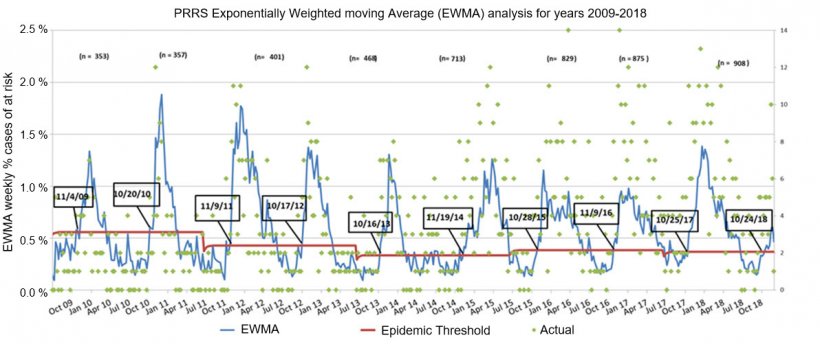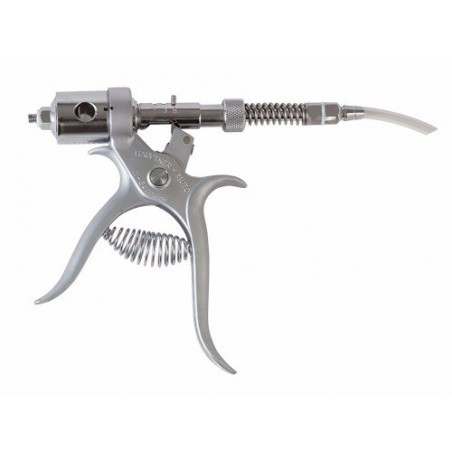The Porcine Reproductive and Respiratory Syndrome (PRRS) is an important economic disease affecting herds worldwide. In breeding herds, PRRS causes a reproductive disorder characterized by increased number of abortions, stillborns, mummies, repeats and pre-weaning mortality rate. The disease affects sow farms in the United States (US) in a cyclical pattern with the onset of the epidemic between mid-October and mid-November (Figure 1). However, one might wonder if the farms that break during the fall/winter are always the same breaking repeatedly. In this article the frequency of US breeding herds having recurrent PRRS breaks (e.g. new introduction or re-break with the resident virus) is described.


The Morrison Swine Health Monitoring Project (MSHMP) is a voluntary program funded by the Swine Health Information Center (SHIC) and led by the University of Minnesota. MSHMP’s long term goal is to develop a set of tools to gather, monitor and analyze disease data in case of a foreign animal disease or an emerging pathogen enters the country. Meanwhile, MSHMP’s short term goal is to encourage participation of producers by delivering value of the shared data. As part of MSHMP’s short goals, the project monitors and analyze breeding herd health status of two of the most important swine diseases, namely PRRS and Porcine Epidemic Diarrhea (PED). Currently, producers accounting for 50% (approximately 3 million sows) of the national US breeding herd are sharing data (e.g. location, herd size, and barn filter status) besides health status. Producers and veterinarians report the health status of the breeding herd weekly allowing us to calculate the number of breaks each week (incidence) and the percentage of sow farms in each disease status (prevalence). Briefly, a break is reported when compatible clinical signs are detected (abortions, stillborn or mummies and/or piglet mortality) and/or a different PRRS virus strain is reported. Sow farm PRRS status are based on the American Association of Swine Veterinarian guidelines for classifying herds (Holtkamp et al., 2011).
As mentioned earlier, the epidemic curve shows a cyclical and seasonal pattern that repeats year after year (Tousignant, 2013). Similar trends with variations in the onset and duration of the epidemic curve can be observed when we break the incidence by states. These differences between states can be the result of regional factors affecting disease spread such as, pig farm density, climate, topography, vegetation or specific regional practices as previously described (Arruda et al., 2018). However, some of the farms located in the same region break more frequent than others suggesting that there may be specific factors related to pig farms.
In the MSHMP database there is PRRS break information for 1018 farms. Of these, approximately 38% (386/1018) have never reported a single outbreak. On the other hand, 18.3% (186/1018) and 43.8% (446/1018) of the farms reported one or more breaks since 2009, respectively. Looking more specifically at farms with recurrent (two or more) viral introductions, a total of 1151 breaks (2.6 breaks per farm on average) have been reported. When the time between outbreaks is calculated, we can see that 71% of the farms reporting a PRRS break today will report a break within the following two years (Figure 2). But why 71% of farms break again after a “short” period of time? Data gathered through MSHMP allows us to further investigate into the different factors that could be leading those farms to break more often than others.

The first and perhaps the most important one is location. Farms that are located in denser pig farm regions in the US tend to have higher frequency of outbreaks. Thus, a breeding herd surrounded by other pig farms will have a higher risk of breaking than a herd located in an isolated region as the risk is higher due to proximity to populations that can be shedding the virus which ultimately can be introduced through different routes (e.g. animal movement, contaminated fomites and even airborne transmission).
A second factor that influences the recurrence of PRRS breaks is disease management. Companies that have herds in high risk regions may not try to eliminate the virus as they perceive that they may break again making an elimination program financially challenging to justify. It has been reported that having some immunity in the herd will reduce the economic impact of a new break (Linhares et al., 2015). Additionally, farms that choose to eliminate the virus are at risk when new gilts are introduced after the closing period (6-8 months). If the disease has been roaming around undetected in the herd at low prevalence, the entrance of susceptible animals can trigger PRRS symptomatology again.
And last but not least, biosecurity compliance. Farms that are not implementing good biosecurity practices will have a higher risk of breaking. Breeding herds that have implemented a robust biosecurity program (e.g. bench entry, shower in-out, truck wash-disinfect-dry after every load, filtration) have managed to reduce the frequency of breaks even in swine dense areas. In another study evaluation of the biosecurity practices, results suggested that events related to swine movements, transmission by air and water, and people movements should be prioritized (Silva et al., 2018).
All in all, even though PRRS seems to be a ubiquitous and inevitable disease in certain areas, a considerable percentage of breeding herds reporting to the MSHMP database have managed to avoid viral introductions. Location and biosecurity measures play a major role in preventing viral introduction.






